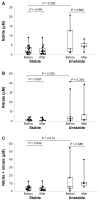Markers that can Reflect Asthmatic Activity before and after Reduction of Inhaled Corticosteroids: A Pilot Study
- PMID: 23943655
- PMCID: PMC3738382
- DOI: 10.4137/BMI.S12537
Markers that can Reflect Asthmatic Activity before and after Reduction of Inhaled Corticosteroids: A Pilot Study
Abstract
Evaluation of airway inflammation is important in achieving adequate dosing of inhaled corticosteroids (ICS) for treating bronchial asthma. However, there is no evaluation tool that can be used in clinical settings. We examined biomarkers that can precisely reflect airway inflammation when ICS are decreased in stable asthmatic patients. This was a 12-week, single-arm, open-label clinical study performed at a single university hospital. Twenty-five patients (6 male and 19 female) with stable asthma were included in this study. We investigated whether the levels of nitrite and nitrate in exhaled breath condensate (EBC) increase after ICS reduction. We also investigated whether blood eosinophils, serum immunoglobulin E (IgE), high-sensitivity C reactive protein (hs-CRP), interleukin (IL)-13, IL-17, and periostin are different before and after ICS reduction. Peak expiratory flow (PEF), pulmonary function tests, asthma control test (ACT), and asthma quality of life questionnaire (AQLQ) were also examined. We considered an unscheduled hospital visit due to asthmatic symptoms and decline in average PEF over one week by more than 10% to indicate disease instability, and compared patients with stable and unstable disease for analysis. Unstable status was detected in 5 patients. Age, sex, asthma duration, ACT and AQLQ scores, and the level of serum IgE did not differ between stable and unstable groups. In the unstable group, the total concentration of nitrite and nitrate at the last visit was 9.84 (6.65-11.24) μM. Surprisingly, this was similar to the concentration at the first visit (5.58 (2.94-17.29) μM). Serum periostin before ICS reduction (141.9 [107.7-147.7] pg/mL) was higher in the unstable group than in the stable group (91.5 [78.75-103.5] pg/mL). The unstable group had a higher peripheral blood eosinophil count and wider diurnal variation of PEF at the first visit compared to the stable group. Higher eosinophils in peripheral blood and wider diurnal variation of PEF were predictive markers for unstable disease after ICS reduction. Serum periostin is another candidate for the predictive marker.
Keywords: bronchial asthma; exhaled breath condensate; inhaled corticosteroid; nitric oxides; periostin.
Figures




Similar articles
-
Inflammatory markers and acid-base equilibrium in exhaled breath condensate of stable and unstable asthma patients.Int Arch Allergy Immunol. 2012;159(2):121-9. doi: 10.1159/000335674. Epub 2012 May 30. Int Arch Allergy Immunol. 2012. PMID: 22653320
-
Leukotrienes and 8-isoprostane in exhaled breath condensate of children with stable and unstable asthma.J Allergy Clin Immunol. 2004 Feb;113(2):257-63. doi: 10.1016/j.jaci.2003.10.046. J Allergy Clin Immunol. 2004. PMID: 14767439 Clinical Trial.
-
Increased periostin associates with greater airflow limitation in patients receiving inhaled corticosteroids.J Allergy Clin Immunol. 2013 Aug;132(2):305-12.e3. doi: 10.1016/j.jaci.2013.04.050. Epub 2013 Jun 19. J Allergy Clin Immunol. 2013. PMID: 23791506
-
High-sensitivity C-reactive protein in the exhaled breath condensate and serum in stable and unstable asthma.Respir Med. 2009 Mar;103(3):379-85. doi: 10.1016/j.rmed.2008.10.003. Epub 2008 Nov 17. Respir Med. 2009. PMID: 19010654
-
Serum periostin: a novel biomarker for asthma management.Allergol Int. 2014 Jun;63(2):153-60. doi: 10.2332/allergolint.13-RAI-0678. Epub 2014 Apr 25. Allergol Int. 2014. PMID: 24759559 Review.
Cited by
-
Serum periostin and carcinoembryonic antigen for diagnosing and assessing response in allergic bronchopulmonary aspergillosis.Lung India. 2025 Jul 1;42(4):309-314. doi: 10.4103/lungindia.lungindia_32_25. Epub 2025 Jun 27. Lung India. 2025. PMID: 40569398 Free PMC article.
-
Early Prediction of Asthma.J Clin Med. 2023 Aug 20;12(16):5404. doi: 10.3390/jcm12165404. J Clin Med. 2023. PMID: 37629446 Free PMC article. Review.
-
Bronchial Asthma as a Cardiovascular Risk Factor: A Prospective Observational Study.Biomedicines. 2022 Oct 18;10(10):2614. doi: 10.3390/biomedicines10102614. Biomedicines. 2022. PMID: 36289876 Free PMC article.
-
Periostin in inflammation and allergy.Cell Mol Life Sci. 2017 Dec;74(23):4293-4303. doi: 10.1007/s00018-017-2648-0. Epub 2017 Sep 8. Cell Mol Life Sci. 2017. PMID: 28887633 Free PMC article. Review.
-
Using Periostin as a Biomarker in the Treatment of Asthma.Allergy Asthma Immunol Res. 2016 Nov;8(6):491-8. doi: 10.4168/aair.2016.8.6.491. Allergy Asthma Immunol Res. 2016. PMID: 27582399 Free PMC article. Review.
References
-
- Kshirsagar NA. Malaria: Anti malarial resistance and policy ramifications and challenges. J Postgrad Med. 2006;52(4):291–3. - PubMed
-
- Radyukhin VA, Serebryakova MV, Ksenofontov AL, Lukashina EV, Baratova LA. Isolation of influenza virus A hemagglutinin C-terminal domain by hemagglutinin proteolysis in octylglucoside micelles. Protein Pept Lett. 2006;13(9):907–13. - PubMed
-
- Suissa S, Ernst P, Benayoun S, Baltzan M, Cai B. Low-dose inhaled corticosteroids and the prevention of death from asthma. N Engl J Med. 2000;343(5):332–6. - PubMed
LinkOut - more resources
Full Text Sources
Other Literature Sources
Research Materials
Miscellaneous

